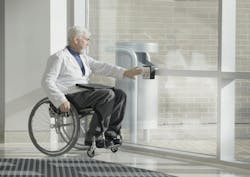This article originally appeared in the August 2024 issue of Security Business magazine. Don’t forget to mention Security Business magazine on LinkedIn and @SecBusinessMag on Twitter if you share it.
No discussion of security in healthcare facilities is complete without considering the proper use of low-energy automatic door operators. They provide convenient, hands-free, low-power point-of-entry door control to help meet U.S. and Canadian Americans with Disabilities Act (ADA) requirements for door installations.
The ADA has required many businesses to install automatic doors to become compliant. ADA compliance – especially in healthcare facilities, but also in any facility – is vital because it ensures that handicapped people are able to access or egress a building with little exertion, despite their physical disability. The elderly also benefit from the law, as many cannot easily open manual doors on their own, whether disabled or not.
The two prevalent accessibility standards in the United States are ICC A117.1-2017 Standard for Accessible and Usable Buildings and Facilities and the 2010 ADA Standards for Accessible Design.
Low-Energy and Automatic Swinging Doors: The Basics
Low-energy swinging doors are governed by ANSI 156.19 and ADA to include the following features and requirements:
- “Knowing Act” activation via pushbutton or push plate;
- Slow opening and closing speeds;
- Low operating force;
- Floor space requirements to allow individuals using wheelchairs or other mobility devices to approach the door, reach the hardware and open it outside of its swing radius, maneuver through the doorway, and close it behind them;
- No guide rails required Clear opening width – 32 inches (815 mm) minimum in power-on and power-off mode – based on clear opening provided by all leaves in the open position.
Low-energy swinging doors deliver a cost-effective alternative to meeting accessibility compliance while still allowing the able-bodied to manually use the swinging door.
Automatic doors hold an outstanding safety record in the U.S. with more than 50 billion safe automatic door openings and closings annually. Automatic doors and components should be manufactured in compliance with the American National Standard for Power Operated Pedestrian Doors, ANSI A156.10, which governs and defines their installation, sensing devices, and safety requirements. Many automatic doors are designed to integrate with a variety of electronic sensors, access control systems, electromagnetic locks, electric strikes, and exit devices for security applications.
Automatic low-energy swinging doors are designed for applications requiring ADA compliance or user convenience. These doors are usually available in three configurations:
- A single door that swings in or out and is left-handed or right-handed (most common);
- A pair of doors that simultaneously swing in the same direction; or
- Double egress – a pair of doors that simultaneously swing in opposite directions.
Low-energy swinging doors deliver a cost-effective alternative to meeting accessibility compliance while still allowing the able-bodied to manually use the swinging door. Additionally, low-energy operators can be retrofitted to existing doors for additional cost savings while providing universal accessibility.
Push Plates and Switches
Whether in a single- or double-door application, there are a variety of ADA-compliant push plates, wall switches, presence sensors, and even wireless controls that can be integrated with low-energy door operators to ensure quiet operation, security, and a positive patient experience.
Infection prevention can also be addressed with wireless, touchless and passive infrared motion detectors to active door opening sequences.
Lock Sequence Control
Many things must be considered when selecting the proper controls for entering or exiting an opening with an automatic door operator. First, determine what will provide appropriate security and life safety and what codes will apply for each opening.
The access and egress sides should be addressed separately – which may impact an integrator’s choice of power supply, power transfer, and logic control options.
Passage may be restricted on one side but not the other. On designated fire exit doors and egress doors, codes will govern the type of acceptable controls. And, consideration must be given to after-hours access, safety, and security for healthcare and LTC (long-term care) facilities.
Considering lock sequence control will ultimately guide an integrator to the proper selection of access and egress control components for use with automatic door operators. Here are a handful of questions to consider:
- What service does the opening provide? Public Access? Private Entrance? Low-energy automatic door openings require coordination with lock control to ensure smooth door operation.
- Should access be restricted? Day/night selection may also be desired.
- Should egress be restricted? How should dementia patient control provide some degree of security without compromising life safety?
- What is the frequency of use of the opening? Maintaining unlocked hours may be required.
- Is the opening a designated egress or local Authority Having Jurisdiction governing your Healthcare or LTC Facility door project?
- How is ADA/handicap accessibility being addressed? You'll need to confirm how the type of traffic impacts your selection of access and egress control components.
Motorized Lock Alternatives
New electrified design innovations are available that are ideal for use with automatic door operator applications, such as motorized latch retraction mortise locksets that ensure the door stays latched even when de-energized – maintaining fire door integrity.
About the Author

Mauricio Lainez
Mauricio Lainez is Product Development Manager for Security Door Controls (SDC).
www.sdcsecurity.com
(800) 413-8783
